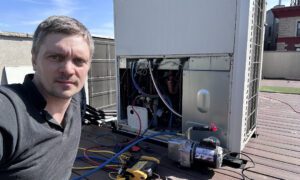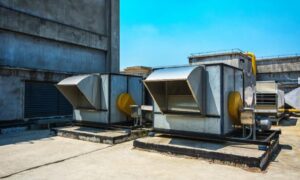This paper explores innovations in HVAC (Heating, Ventilation, and Air Conditioning) systems, highlighting the shift toward sustainable and eco-efficient solutions, with an emphasis on renewable energy usage, intelligent automation, and efficient design. However, despite technological advancements, some outlier cases and unexpected outcomes have challenged established norms and prevailing theories. This study investigates these exceptions, analyzing potential reasons for the discrepancies and what they reveal about the limitations of traditional approaches. Through a comparative analysis of unsuccessful innovative implementations and solutions that failed to meet expected efficiency goals, the paper proposes new theoretical perspectives for HVAC engineering. The investigation suggests that the observed failures do not indicate a failure of the innovations themselves but rather the rigid application of traditional models in contexts that require adaptive flexibility and a more holistic approach.
- Context and Central Question:
The field of HVAC systems (Heating, Ventilation, and Air Conditioning) is continuously evolving, always striving for a balance between energy efficiency, environmental sustainability, and user comfort. In recent years, the integration of renewable energies, such as solar and geothermal, along with intelligent automation systems, has emerged as the key to reducing environmental impacts. The adoption of these innovations aims not only to improve the energy performance of buildings but also to contribute to the fight against climate change and the reduction of carbon emissions.
Although these technological advancements are promising, their implementation has not always yielded the expected results. In various situations, HVAC systems based on renewable energy sources or controlled by artificial intelligence have failed to achieve the promised efficiency. The predominant theory, which suggests that the introduction of these innovations will lead to effective solutions to energy consumption problems, seems to be challenged by these outlier cases. Thus, there is a discrepancy between the theoretical predictions and the practical reality of these implementations.
This phenomenon raises an important central question: why do some innovative HVAC systems fail to deliver the expected results, and what do these cases teach us about the limitations of traditional theories and approaches to energy efficiency and sustainability? By investigating the reasons for these unexpected failures, it is possible to identify shortcomings in the traditional models of applying these systems and seek solutions that improve flexibility in implementing these innovations.
Therefore, the objective of this study is to explore these exceptions and divergences, discussing how they challenge established norms in mechanical engineering and offering a reflection on the need for a new theoretical approach. Through this, the paper aims to contribute to the evolution of HVAC systems by providing a more robust foundation for their future development and adaptation to the real needs of buildings and users.
- Theoretical Background and Analogous Cases:
The fundamental theory underlying the evolution of HVAC systems is based on principles of energy efficiency and sustainability. Thermal efficiency, optimized temperature control, and emission reduction are the cornerstones of modern HVAC system design. Traditional models, such as the use of conventional electric power to fuel climate control systems and manual mechanical control, are being progressively replaced by technologies based on renewable sources and intelligent automation.
Studies on the evolution of HVAC systems suggest that new technologies have been quite successful in many contexts, especially in developed countries and high-energy-performance buildings. However, there is a discrepancy between theoretical expectations and practical results in certain scenarios. Analogous cases can be found in other areas of engineering, such as sustainable public transportation systems or the adoption of solar energy technologies in residential buildings, where initial expectations have not always materialized. The literature on these cases of unexpected failures suggests that a possible explanation lies in the specific context of implementation and the adaptation of systems to variable environments. In HVAC, local climate, existing infrastructure, and user behavior patterns can play a significant role in the failure of innovative systems.
- Methodological Approach for Analyzing Outlier Cases:
The analysis of outlier cases involving innovations in HVAC systems required a rigorous methodological approach, based on a combination of qualitative and quantitative analysis. To identify these cases, a series of projects were initially selected where new technologies had been implemented, but the results fell short of energy efficiency expectations. These projects spanned various types of buildings, from commercial to residential, and were chosen based on the diversity of technologies applied.
Quantitative data on HVAC system performance were then collected, including energy consumption measurements, operational costs, and efficiency indices compared to initial projections. These data were supplemented with interviews and surveys conducted with engineers, designers, and end-users of the systems to understand the variables that might have influenced the unexpected results. The aim was to capture not only technical failures but also human and contextual aspects that could have affected system performance.
The comparative analysis between successful projects and those that experienced failures helped identify common patterns in the observed discrepancies. It became evident, for example, that in some cases, the failures were not necessarily related to the technology itself, but rather to inadequate system sizing or a lack of adaptation to the local climate and user behavior. The adopted methodology thus allowed for a deeper understanding of the factors involved in these failures, going beyond a mere technical analysis.
Finally, the qualitative analysis was essential in identifying the nature of the failures and how they could be overcome in future projects. This involved exploring the reasons behind the failure or suboptimal performance of the systems and identifying potential solutions, such as the need for a more flexible approach in HVAC system design. This process of critical reflection was crucial for developing new theoretical and practical directions in the field of mechanical engineering. 4. Presentation and Detailed Analysis of Outlier Cases:
The detailed analysis of outlier cases involved a thorough review of several projects in which innovations in HVAC systems did not meet energy efficiency and sustainability goals. One significant example was a commercial building that adopted a hybrid system based on solar and geothermal energy. The expectation was that the system would cover up to 80% of the energy demand, but in practice, its performance fell well short, covering only 60%. The causes of this unsatisfactory outcome were attributed to errors in the sizing of the solar system, which was unable to generate sufficient energy during periods of low solar radiation, and limitations in the geothermal source, which did not provide a constant supply of energy.
Another notable case involved a residential building that implemented an intelligent ventilation system, designed to automatically adjust temperature and humidity based on occupancy patterns and external weather conditions. However, the system failed to achieve energy efficiency goals due to a lack of adaptation to variations in the residents’ behavior. Although technologically advanced, the system was unable to anticipate changes in space usage and energy consumption patterns, leading to significant resource waste.
These cases highlight that failures in innovative HVAC systems are often not due to inherent problems in the technologies themselves, but rather a disconnect between the sizing models and the variable factors of the real-world application context. The study also revealed that many failures could be attributed to the lack of system customization, which was not designed to account for the specific needs of each building or the unpredictable behaviors of users. This aspect underscores the importance of considering local variability and adaptive use in the initial planning and design stages.
By analyzing the data and interviews, it became clear that most failures could have been avoided or minimized with a better understanding of environmental and behavioral conditions, and a more flexible approach to system implementation. These outlier results provide valuable insights into the limitations of existing models and point to the need for a revision of HVAC design and implementation strategies to ensure systems are more suited to practical realities.
- Theoretical Implications and New Perspectives:
The analysis of outlier cases presented significant implications for existing theories on energy efficiency and the sustainability of HVAC systems. One of the main conclusions was that traditional design and implementation models for these systems, often based on rigid assumptions of uniformity and predictability, fail to capture the complexity of local and behavioral variables. This suggests that the theories underpinning these innovations need to be rethought to incorporate more flexibility and adaptability, considering a broader range of contexts and specific conditions.
Additionally, the results emphasize the need for a more holistic approach to HVAC system design. Instead of relying exclusively on specific technologies or universal solutions, projects should consider the dynamic interaction between environmental, behavioral, and technological factors. Adapting HVAC systems to the variable conditions of each environment, as well as customizing them to meet user needs, is crucial to ensuring their long-term effectiveness and sustainability.
A new theoretical perspective could involve the introduction of models based on adaptive flexibility, which account not only for technical factors but also for human and contextual variabilities. These models could be integrated into intelligent systems that automatically adjust operational parameters according to real-world usage conditions and environmental changes. This approach would allow the creation of HVAC systems that are more resilient and efficient in the face of daily variations and unforeseen circumstances.
Finally, these insights open the door for redefining the concept of “efficiency” in HVAC systems, suggesting that, to truly achieve sustainability, it is necessary to move away from generic solutions and invest in more personalized and flexible strategies. Current theories must evolve to reflect this new vision, incorporating the complexity of systems and the diversity of situations in which these systems operate.
- Final Considerations and Future Directions:
The conclusions of this study highlight that, while promising, innovations in HVAC systems face significant challenges when applied without due consideration of local and behavioral variables. The analysis of outlier cases revealed that failures in outcomes are more related to design and sizing issues than to the technology itself. These findings indicate that there is a need for adjustments in the theoretical and practical approaches to the development and implementation of these systems, with an emphasis on greater flexibility and customization.
The study also pointed to the importance of incorporating new theoretical models, such as adaptive flexibility, which consider the complex interactions between environmental, technological, and human factors. This would pave the way for the development of more robust HVAC systems capable of adapting to a wider range of contexts, improving energy efficiency and sustainability.
For future research, it is essential to explore how HVAC systems can be designed not only to adjust to environmental conditions but also to respond intelligently to changes in user behavior. The creation of more accurate simulations, integrating behavioral and climatic data, could be a promising direction for the evolution of these systems.
In summary, this study not only challenges existing theories but also suggests a new path for the evolution of HVAC systems, where flexibility and customization are the cornerstones of long-term success.
About the Author:
Glauco Tulio Zonato is a Mechanical Engineer with 19 years of experience, recognized for his leadership in large-scale projects in the HVAC and Civil Engineering sectors. Throughout his career, he has stood out in significant ventures such as the expansion of the Novo Nordisk factory and the renovation of Congonhas Airport, where he demonstrated his ability to lead and execute complex projects with excellence. His experience also includes the modernization of the fire protection system at the Federal Justice building and the HVAC systems of large buildings, always focusing on innovation and efficiency.
In addition to his solid technical expertise, Zonato plays a strategic role as an entrepreneur, being a co-owner of PAYCO Santa Felicidade Real Estate Ventures and ZONATO TRANSPORTADORA, where his vision and management skills have been key to the success of these ventures. His work reflects a constant commitment to quality, profitability, and the delivery of high-level solutions in challenging projects, establishing him as one of the most respected professionals in the sector.
References:
- ASHRAE (American Society of Heating, Refrigerating and Air-Conditioning Engineers). (2019). ASHRAE Handbook—HVAC Systems and Equipment. Atlanta, GA: ASHRAE.
- Cengel, Y. A., & Boles, M. A. (2015). Thermodynamics: An Engineering Approach (8th ed.). New York: McGraw-Hill Education.
- Morris, P. (2011). Renewable Energy in Buildings: An Integrated Approach. London: Routledge.
- Sartori, I., & Hestnes, A. G. (2007). Energy Use in the Building Sector: A Review of the Current State of Research. Energy, 32(4), 493–500. https://doi.org/10.1016/j.energy.2006.10.014
- Levine, M. D., & Dufresne, D. (2008). Building Energy Efficiency: Why Green Buildings Aren’t Always as Green as We Think. Energy Policy, 36(8), 2760-2774. https://doi.org/10.1016/j.enpol.2008.04.004



































